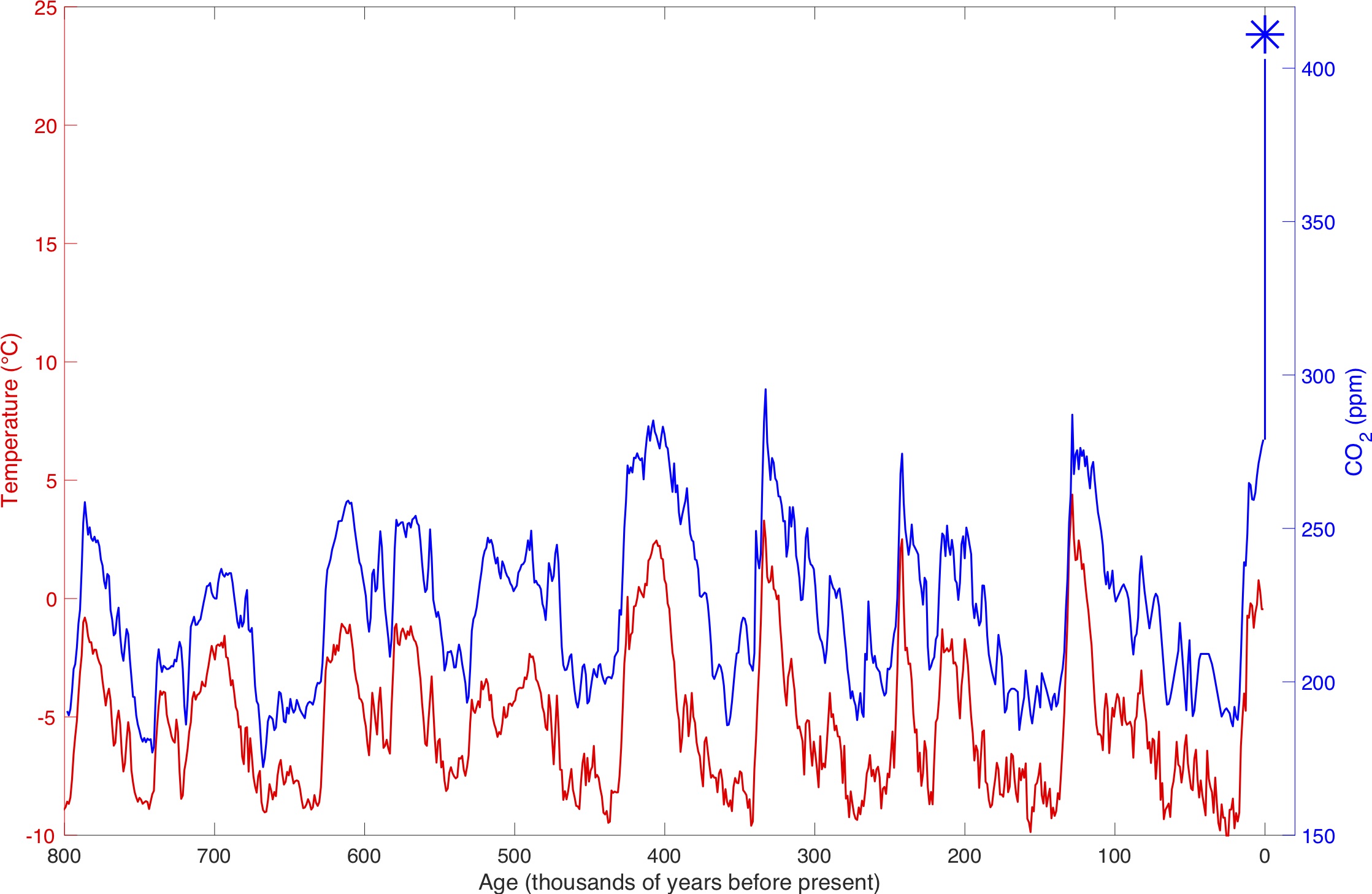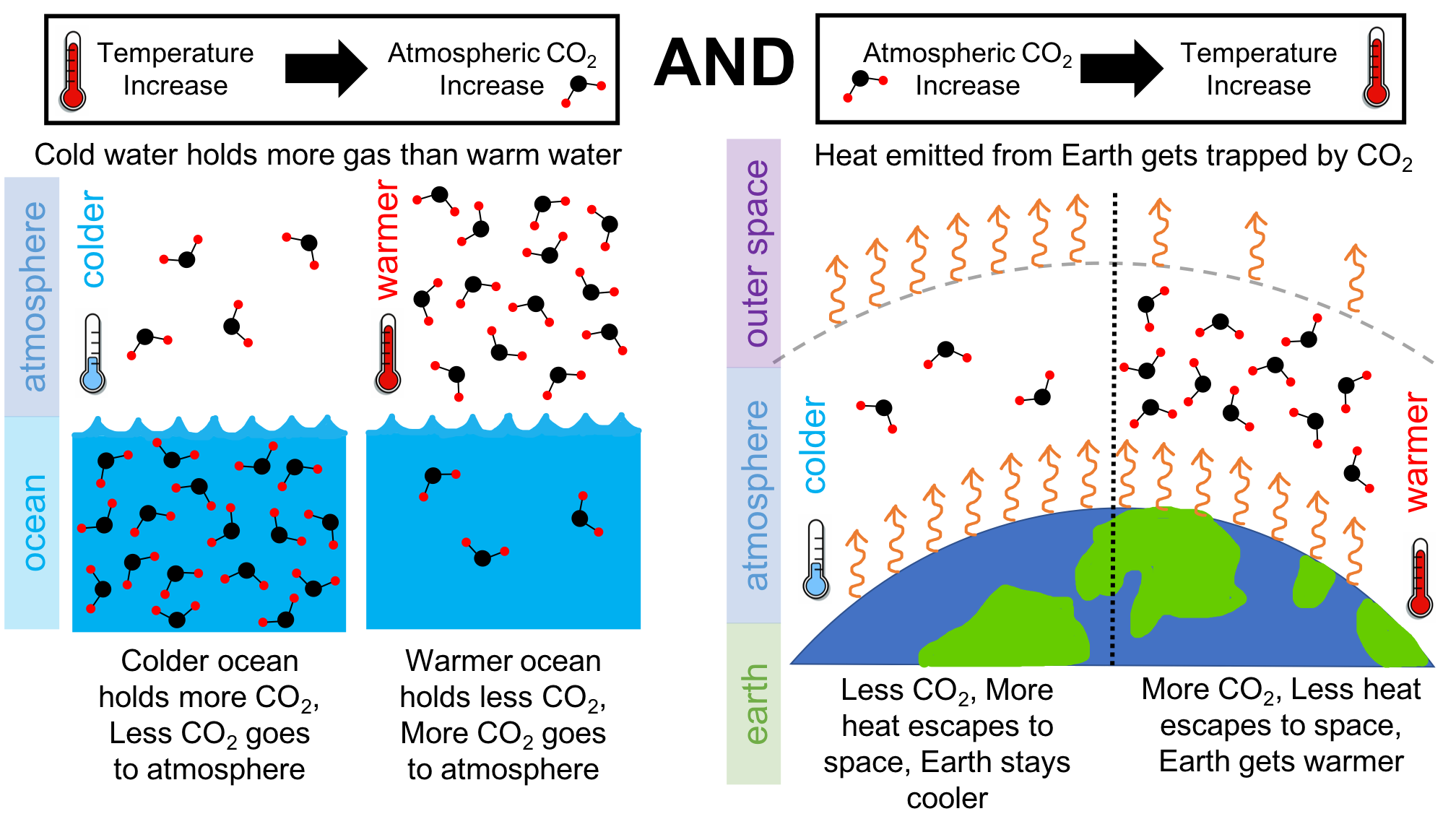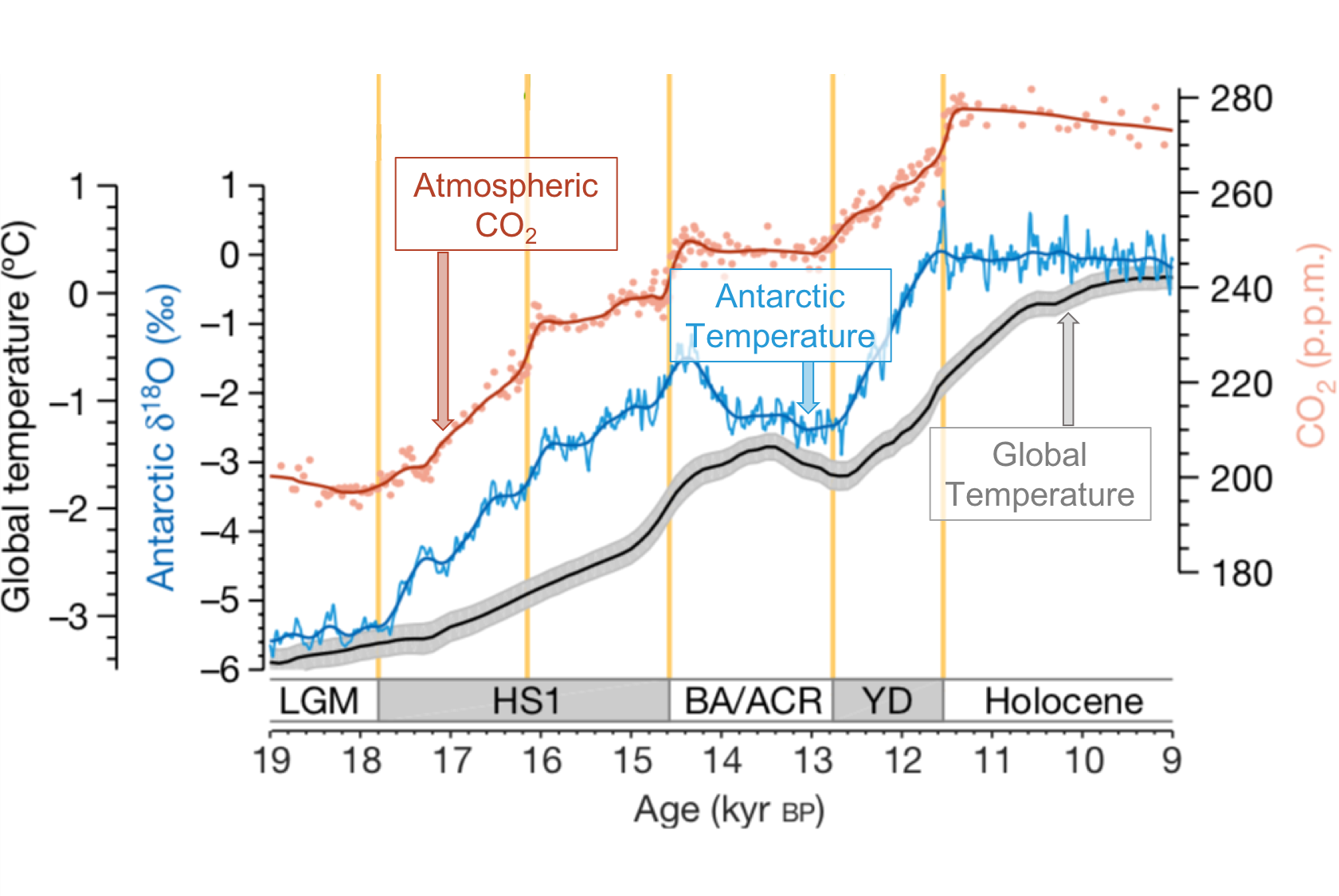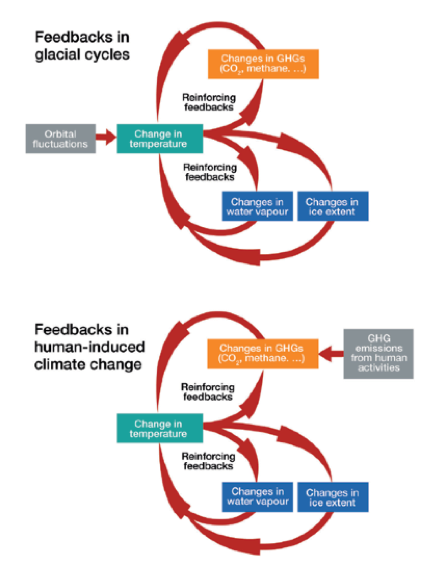CO2 lags temperature - what does it mean?
What the science says...
| Select a level... |
 Basic
Basic
|
 Intermediate
Intermediate
|
 Advanced
Advanced
| ||||
|
Increasing concentration of CO2 in the atmosphere increases global temperature. Increasing global temperature also increases the concentration of CO2 in the atmosphere. Yes, you can have both. Antarctic ice core records of past climate change help us understand earth’s climate system and show that human-caused climate change is fundamentally different from natural glacial-interglacial climate cycles. |
|||||||
Climate Myth...
CO2 lags temperature
"An article in Science magazine illustrated that a rise in carbon dioxide did not precede a rise in temperatures, but actually lagged behind temperature rises by 200 to 1000 years. A rise in carbon dioxide levels could not have caused a rise in temperature if it followed the temperature." (Joe Barton, US House of Representatives (Texas) 1985-2019) - Full Statement
Background of the myth:
Earth’s climate has varied widely over its multi-billion year history -- from ice ages characterized by large ice sheets covering many land areas, to warm periods with no ice at the poles. Several factors have affected past climate change, including solar variability, the tilt and wobble of the Earth's orbit relative to the sun, volcanic activity, and changes in the composition of the atmosphere. Using data from Antarctic ice cores, we can explore what climate cycles have looked like over the past 800,000 years (Figure 1). Over this time period, CO2 and temperature are closely correlated, which means they rise and fall together. However, based on some Antarctic ice core data, changes in CO2 appear to follow changes in temperatures by about 600 to 1000 years. That is to say that changes in CO2 lag, or come after, changes in temperature. This has led some to incorrectly conclude that CO2 cannot be responsible for the current rise in Earth’s temperature.

Figure 1. The EPICA Dome C ice core from East Antarctica provides the current longest ice core record, going back 800,000 years. From the core, scientists can measure past levels of CO2 in the atmosphere and estimate temperature changes over the period of the record. The modern level of CO2 in the atmosphere is plotted with the * to provide a reference.
Here are four reasons why this conclusion is incorrect:
1. This myth presents a false dichotomy: it frames a false choice between two options when both are actually true.
A false dichotomy forces a choice between two options when there may be other possibilities or both options might be viable. This myth presents a false dichotomy by claiming that if global temperature increased before atmospheric CO2 increased, then an increase in atmospheric CO2 cannot cause a rise in temperature. In fact, both of these cause-and-effect relationships exist within the Earth’s climate system:
a) An increase in global temperature leads to an increase in atmospheric CO2 due to warming of the ocean. Because CO2 can dissolve into water, Earth’s oceans also store CO2. The colder the ocean, the more CO2 it can store; and the warmer the ocean, the less CO2 it can store. (Test this out yourself by comparing what happens when you open a warm versus a cold soda bottle). When the global temperature increases, the temperature of the ocean increases, and, absent other factors, the ocean will emit CO2 into the atmosphere, causing CO2 in the atmosphere to increase.
b) An increase in atmospheric CO2 leads to an increase in global temperature due to the Greenhouse Effect. With more CO2 in the atmosphere, more of Earth’s heat is trapped and cannot escape out to space, warming the planet.

Based on these physical processes, it’s clear that increased atmospheric CO2 leads to increased global temperature and this warming can also cause CO2 in the atmosphere to increase. We call this reinforcing relationship a positive feedback.
2. This myth doesn’t distinguish between local Antarctic temperature and global temperature.
The myth relies on the Antarctic ice core record to provide information about global climate change. The CO2 record in ice cores gives a global representation of atmospheric CO2 levels because CO2 is a well-mixed gas in the atmosphere. However, the temperature record in ice cores only gives the local Antarctic temperature because it reflects temperature changes at the site of the core. When we look at a record of global temperature change, reconstructed from a combination of other records all around the planet, we see a different story. Figure 2 shows that at the end of the last ice age, the rise in global temperature increased after the rise of Antarctic temperature and global CO2. This global change illustrates the power of the positive feedback described above: the increase in global atmospheric CO2 led to an increase in global temperature which led to further increase in atmospheric CO2 which led to further increase in global temperature, and so on and so on...

Figure 2. At the end of the last ice age, approximately 18,000 years ago, the global temperature (black) began to increase after the rise in CO2 in the atmosphere (red) and the rise in Antarctic temperature (blue). Figure from Brook and Buizert 2018.
3. This myth conflates the past with the present.
This myth assumes that the drivers of modern climate change are the same as the drivers of past climate change. It’s certainly true that we can learn a lot about how Earth’s climate system works by studying records of past climate change, and this understanding of Earth’s climate is critical to understanding modern climate change. However, this does not mean that the causes of changes in the past are the same as the causes of changes in the present. In fact, the ice core record shows us that modern climate change is fundamentally different from past climate change.
The ice age cycles over the past 800,000 years were driven by small changes in the Earth’s orbit around the Sun. The impact of these small changes was amplified by feedbacks in the climate system, such as the temperature-CO2 feedback described above, leading to the large swings in temperature and CO2 as well as the growth and retreat of ice sheets covering significant portions of Earth’s land. Thus past ice age changes were initiated by changes in Earth’s orbit and then amplified by the temperature-CO2 feedback.
In contrast, modern climate change is fundamentally different because it has been initiated by human-caused emissions of CO2 into the atmosphere through the burning of fossil fuels (e.g. coal, oil, and natural gas). Adding CO2 to the atmosphere sets off the same climate mechanisms and feedbacks that shaped ice age changes, but for an entirely different reason. The current level of CO2 is about 1.5 times higher than it has been before in the ice core record and has risen to that level in only a couple hundred years (extremely quickly), since the start of the Industrial Revolution in the late 1800s. For the last 800,000 years, CO2 in the atmosphere never exceeded 300 parts per million. The recent rise in CO2 in the atmosphere has gone from around 280 ppm in 1880 to about 409 ppm in 2019 (NOAA). The current level of CO2 and its rate of increase are unprecedented in the ice core record. The fundamental physical, chemical, and biological interactions that shape Earth’s climate system have not changed in the last 800,000 years, but the conditions of the atmosphere that drive the climate system have. While records of past climate changes may not be exactly the same as changes we see today, they can provide examples of how the fundamental system responds to the kinds of climate changes happening today.

Figure 3. From The Science of Climate Change, Kurt Lambeck, 2010.
4. This myth is based on old data.
This myth, written in a position statement by Joe Barton in 2011, is based on outdated ice core data. The conclusions of the referenced study weren’t incorrect, but newer ice core data and analysis techniques with smaller uncertainties gives us a clearer picture of the relative timing of increases in Antarctic temperature and atmospheric CO2. Newer ice core records show that increases in Antarctic temperature occurred before a global CO2 increase only by as much as a few hundred years or by as little as no time at all. In fact, the most recent papers conclude that these changes occurred so close together that we really cannot distinguish which happened first (Pedro et al. 2012, Parrenin et al. 2013, Marcott et al. 2014, Brook and Buizert 2018).
However, regardless of the exact timing of temperature and CO2 change, the fact remains that those changes were fundamentally different from today’s changes, as described above. The ice core record puts modern CO2 and climate changes into context, showing how different they are from changes in the last 800,000 years. Ice cores also give us insight into how the Earth’s climate system works and how it may respond to the modern human-caused changes to the climate system we see today.
Last updated on 18 February 2021 by eckahle. View Archives































 Arguments
Arguments












































Caillon 2003 constrains the CO2 lag to 800 ± 200 years (but again, no error bars):
Stott 2007 finds similar results - a CO2 lag of 1000 ± 300 years. Stott does include 200 year uncertainty on the benthic ages (in fact, Stott's graph includes everything but the kitchen sink):
Without knowing which older studies you're talking about, the most recent studies with up to date (and dare I say the most accurate) data (Monnin 2001, Caillon 2003) paint a similar picture of Southern warming -> CO2 rise -> Northern warming. But if you do know of any pertinent older papers, it'd be great if you could post the links here. And kudos for sticking it to the man :-)
Quietman 'How do we know that the planet isn't returning to Earth Normal or Earth Mean temperature?' Are you seriously proposing a new theory - that the Earth has a memory? Do you have a mechanism? Or a 'setting' to which this 'memory' is adjusted? Is there any peer-reviewed literature as a source? CO2 clearly cannot be meaningless, it has long been known to be infra-red active and remains resident in the atmosphere for a long time, from memory ~33% remains after one hundred years and 20% after a thousand years, but there is a long tail meaning that some will remain for tens of thousands of years, causing significant warming. Inevitably, this alone will affect the net heat balance of the Earth. Of course CO2 is NOT the only GHG and as temperature increases, so does the water vapour, which acts as a positive feedback amplification. But while water vapour is a stronger GHG than CO2, it does not remain in the atmosphere for long. The source of the excess CO2 is explained by the shifting isotopic ratio of the atmospheric carbon. From this it is known to originate from non-biological sources - i.e. fossil carbon: coal, oil & gas. Regarding CO2, the Mauna Loa CO2 readings overlap ice core data during the period 1959-1978. The CO2 readings obtained match perfectly during the overlap. AFAIK, the oldest ice cores are ~ 1000 ky old. Here's one with the source data and references - so that YOU can check its authenticity! Image:Carbon_History_and_Flux_Rev_png and Image:Carbon_Dioxide_400kyr_Rev_png Sorry, but I couldn't locate a version in the p/r literature. I've seen them before, it's just that I couldn't find any. We are clearly performing a global experiment and no-one can be absolutely certain as to the precise outcome, but if it does all go dreadfully wrong, the trouble is that we are INSIDE the test-tube! It would therefore be a really good idea to heed the scientists and stop trying to light the Bunsen burner! Let's cut-back on the use of fossil-fuels, through improved technology, energy conservation & efficiency and renewable energy generation. The economic argument that carbon taxes will damage the US economy is bogus. “As Congress prepares to debate new legislation to address the threat of climate change, opponents claim that the costs of adopting the leading proposals would be ruinous to the U.S. economy. The world’s leading economists who have studied the issue say that’s wrong” http://www.cis.yale.edu/opa/newsr/08-03-19-02.all.html We owe it to the next generation and generations to come to hand over the Earth in the same condition as it was when we received it. Sadly, this will not be the case.
Note - globalwarmingart.com usually cites his sources if you want to track down the original studies where he get the data from.
Quietman, Another thought: Those graphs in my previous post show a rapid upward acceleration of CO2 in recent decades, one that matches the accelerated warming. If what you suggest were true: namely that Earth is [your hypothesis] 'returning' to 'normal', then one would expect an ever decreasing asymptotic approach. Instead, what is seen in the second graph is a rapid departure upwards from the upper bound historic values - the exact reverse of what is expected. Image:Carbon_Dioxide_400kyr_Rev_png Oops! your theory is shot full of holes!